In the intricate machinery of a vehicle, the wheel hub bearing stands as a fundamental and indispensable component. It plays a pivotal role in ensuring the smooth rotation of the wheels and facilitating the seamless transfer of loads, thereby contributing significantly to the overall performance, safety, and durability of the vehicle.
Working Principle
The wheel hub bearing serves as the crucial connection between the wheel and the vehicle's suspension system. Its primary function is to enable the wheel to rotate freely with minimal friction while supporting the weight of the vehicle and withstanding various forces exerted during driving. Comprising an inner ring, an outer ring, rolling elements (such as balls or rollers), and a cage, the wheel hub bearing operates on the principle of rolling friction. As the wheel turns, the rolling elements roll between the inner and outer rings, reducing the resistance to rotation and allowing the wheel to spin smoothly.
Types of Wheel Hub Bearings
There are several types of wheel hub bearings, each designed to meet specific requirements and applications. The two most common types are ball bearings and tapered roller bearings. Ball bearings are known for their ability to handle both radial and axial loads, making them suitable for a wide range of vehicles. They offer smooth operation and relatively low friction, contributing to improved fuel efficiency. Tapered roller bearings, on the other hand, are designed to handle heavier radial and axial loads, making them ideal for applications where durability and load - carrying capacity are crucial, such as in trucks and SUVs.
Applications
Wheel hub bearings find extensive applications in the automotive industry, being an essential component in cars, trucks, buses, and other vehicles. They are also used in various industrial and agricultural machinery, as well as in some aerospace applications. In the automotive sector, the performance of the wheel hub bearing directly impacts the vehicle's handling, stability, and ride comfort. A well - functioning wheel hub bearing ensures smooth steering, reduces vibrations, and enhances the overall driving experience.
Development Trends
With the continuous advancement of automotive technology and the increasing demand for higher performance and reliability, the wheel hub bearing industry is witnessing several notable development trends. One of the key trends is the integration of sensors into wheel hub bearings. These sensors can monitor various parameters such as wheel speed, temperature, and vibration, providing valuable data for the vehicle's electronic control systems. This enables features like anti - lock braking systems (ABS), electronic stability programs (ESP), and predictive maintenance, enhancing vehicle safety and performance. Another trend is the development of more lightweight and compact wheel hub bearing designs. By reducing the weight of the bearing, vehicle manufacturers can improve fuel efficiency and reduce emissions. Additionally, advancements in materials and manufacturing processes are leading to the production of more durable and reliable wheel hub bearings, capable of withstanding harsh operating conditions and longer service intervals.
Maintenance and Replacement
Proper maintenance of wheel hub bearings is crucial to ensure their optimal performance and longevity. Regular inspection for signs of wear, such as abnormal noise, vibration, or play in the wheel, is essential. Lubrication is also a key aspect of maintenance, as it helps to reduce friction and prevent premature wear. In some cases, wheel hub bearings may need to be replaced if they become damaged or worn beyond repair. It is important to use high - quality replacement bearings and follow the manufacturer's guidelines for installation to ensure proper fit and performance.
In conclusion, the wheel hub bearing is a critical component in the world of transportation and machinery. Its continuous evolution and improvement are driving the development of more efficient, safe, and reliable vehicles and equipment. As technology continues to advance, we can expect to see even more innovative and high - performance wheel hub bearing solutions in the future.

 Your message must be between 20-3,000 characters!
Your message must be between 20-3,000 characters! Please check your E-mail!
Please check your E-mail!  Your message must be between 20-3,000 characters!
Your message must be between 20-3,000 characters! Please check your E-mail!
Please check your E-mail! 

